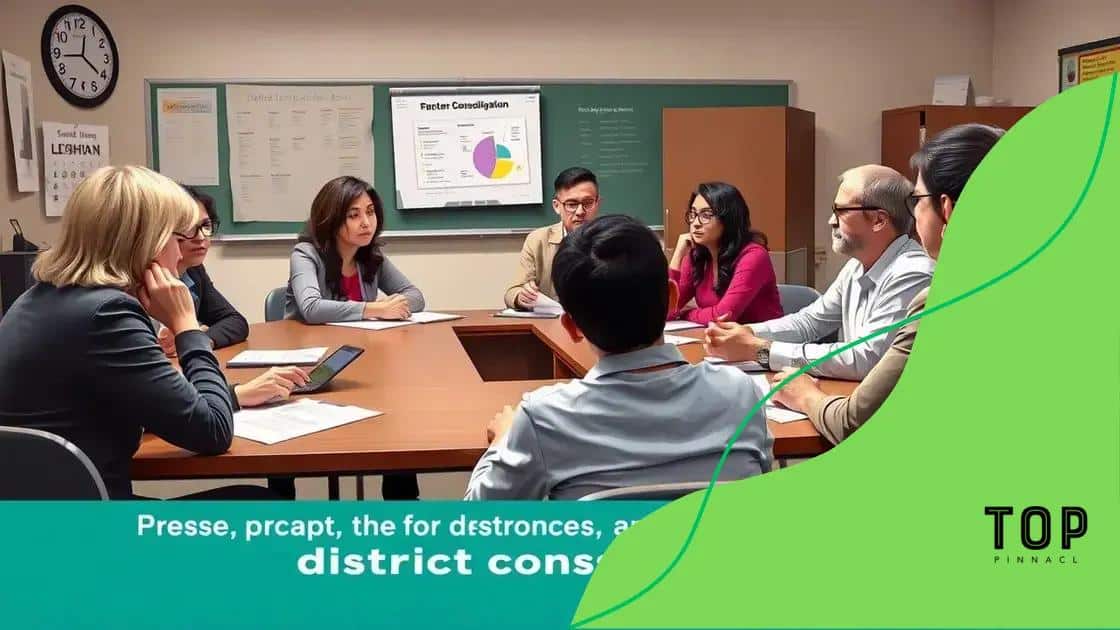School district consolidation proposals: the benefits and challenges
School district consolidation proposals aim to enhance educational outcomes by improving resource allocation, offering diverse programs, and fostering community collaboration, while addressing challenges like stakeholder resistance and cultural integration.
School district consolidation proposals are gaining attention as communities seek to improve educational outcomes. But what does this mean for students and local resources? Join us as we explore the implications of these proposals.
Understanding school district consolidation
Understanding school district consolidation is essential for grasping its impact on education. This process involves merging two or more school districts into one, which aims to improve efficiency and resource allocation. But why is this becoming a more common topic of discussion?
Reasons for Consolidation
Many communities are considering consolidation due to various factors. These can include declining student enrollment, budget constraints, and the need for improved educational services. Each of these reasons plays a vital role in the decision-making process.
- Declining enrollment can lead to fewer resources.
- Consolidation may help save on operational costs.
- Improved educational opportunities for students can result.
These advantages can make a compelling case for many districts. However, understanding the implications requires looking at more than just the benefits.
Impact on Communities
The impact of school district consolidation extends beyond just budget savings. When districts merge, the community’s identity can shift. Local schools often serve as community hubs, and losing these can have emotional and social repercussions for residents.
Moreover, when districts consolidate, they must consider how to effectively bring together different cultures and educational philosophies. The challenge lies in merging established traditions while striving for a unified mission. Public engagement becomes crucial, as it helps address community concerns and preferences.
In some cases, consolidating districts has resulted in significant improvements in student performance. Resource sharing often leads to better facilities and access to more diverse programs. However, this isn’t guaranteed without careful planning and execution.
Addressing Potential Drawbacks
While there are clear benefits, it’s important to recognize and address potential drawbacks of school district consolidation. Some districts face resistance from stakeholders, including parents and teachers.
- Loss of local control can lead to dissatisfaction.
- Potential job losses in administration and teaching staff.
- Cultural clashes between different districts.
As districts navigate these challenges, the role of transparent communication and inclusive planning cannot be overstated. Stakeholder engagement ensures that everyone’s voice is heard, which is essential for a successful transition.
Advantages of consolidating districts
One of the main advantages of consolidating districts is the potential for enhanced educational resources. When districts come together, they can pool their funding and assets. This leads to better facilities, more extracurricular activities, and advanced technology in classrooms.
Improved Financial Efficiency
Consolidation can result in significant cost savings. By combining administrative functions, districts can lower overhead costs. This can free up funds for essential programs and hiring qualified teachers.
- Reduction in duplicated administrative roles.
- Shared transportation and maintenance services.
- Lower costs through bulk purchasing of materials.
These financial benefits can directly impact student learning experiences and educational outcomes. However, financial efficiency isn’t the only advantage.
Broader Educational Opportunities
By consolidating, districts can offer a wider array of programs and services. Smaller districts often struggle to provide comprehensive programs due to limited resources. In contrast, larger, consolidated districts can support:
- Diverse courses in arts and sciences.
- Advanced placement and specialized programs.
- Access to specialized staff and expertise.
This broader range of opportunities can attract families to the area, contributing to a thriving community. Furthermore, a more extensive school system can facilitate collaboration and innovation among educators.
Community and Cultural Integration
Another advantage is the potential for improved community ties. Consolidation can unite residents around common goals for student success. When parents, teachers, and community members come together, they can develop a unified vision for education.
This strong sense of community can lead to increased participation in school events and initiatives. Such involvement enhances student morale and creates a supportive environment conducive to learning.
In summary, the advantages of consolidating districts span improved financial management, a broader range of educational opportunities, and stronger community ties. These factors can work together to create a more effective educational landscape for all students.
Challenges faced by consolidated districts

Consolidated districts face several challenges as they work to combine resources and efforts. While the potential benefits can be significant, the journey to successful consolidation is often complex and requires careful planning.
Resistance from Stakeholders
One major challenge is the resistance from various stakeholders, including parents, teachers, and community members. Many people may feel uncertain about the changes and how they will affect their children’s education. Addressing these concerns through open communication is crucial.
- Parents may fear a loss of local control over schools.
- Teachers might be concerned about job security and changes in their roles.
- Community members may worry about the future of their local schools.
Building trust with stakeholders through transparency can help mitigate these fears and create a more supportive environment.
Cultural Integration
Another significant challenge is the integration of different school cultures and traditions. Each district often has its own educational philosophies, practices, and community expectations. Merging these can be daunting.
To address this, districts need to promote inclusivity and respect for diverse perspectives. This includes involving teachers and community leaders in shaping a shared vision. Such collaboration helps both educators and students feel valued in the new environment.
Funding and Resource Allocation
Funding is a critical aspect that poses challenges for consolidated districts. Different districts may have varying levels of funding and resources. Ensuring fair distribution after consolidation can be tricky.
- Balancing budgetary needs while meeting diverse student requirements can be complex.
- Addressing disparities in infrastructure and facilities between districts.
- Securing additional funding to support integration and program offerings.
This financial aspect requires strategic planning and advocacy to ensure that all students benefit equally from the consolidation.
In summary, challenges such as resistance from stakeholders, cultural integration, and funding issues require careful navigation to achieve a successful consolidation of school districts.
Case studies of successful consolidations
Examining case studies of successful consolidations provides insights into effective strategies that can lead to positive outcomes. These examples showcase how school districts have managed to merge successfully while enhancing educational quality.
Example 1: Hillsborough County, Florida
Hillsborough County is a prime example where consolidation has proven beneficial. This district merged several smaller districts to create a larger, more unified system. The process focused on integrating resources and aligning educational goals. As a result, they improved student achievement scores through:
- Enhanced teacher training programs.
- Increased access to advanced placement courses.
- Shared technology resources that improved learning environments.
This case highlights how combining forces can unlock new opportunities for students and educators alike.
Example 2: San Diego, California
Another successful case is in San Diego, where community engagement played a pivotal role in the consolidation process. Parents and local leaders participated actively, voicing their concerns and suggestions. By aligning the academic programs of the merged districts, they were able to:
- Streamline administrative operations.
- Establish uniform standards across schools.
- Create specialized programs that cater to diverse student needs.
The focus on collaboration ensured that the interests of all stakeholders were considered, making the transition smoother.
Example 3: Adams County, Colorado
In Adams County, the consolidation aimed at addressing declining enrollment and budget shortfalls led to significant improvements. Leaders worked closely with the community to redesign the educational framework. Benefits observed included:
- Access to better facilities and resources for all students.
- Collaboration between educators across the new district.
- Initiatives focused on special education and at-risk students.
These successful case studies illustrate the potential benefits of school district consolidation when approached thoughtfully and inclusively. They show how strategic planning, community engagement, and resource sharing can lead to improved educational outcomes for students.
Future of school district proposals
The future of school district proposals is shaping up to be dynamic and focused on enhancing educational experiences for students. As communities grapple with changes in population and funding, these proposals will likely reflect a growing need for innovation.
Emphasis on Collaboration
Future proposals will emphasize collaboration among districts and community stakeholders. By working together, they can share best practices and resources. This approach helps to tackle issues like funding disparities and educational inequities.
- Joint programs can be developed to streamline services.
- Shared academic resources can increase opportunities for students.
- Collaboration fosters community engagement and support.
This shift towards teamwork will create a more robust educational landscape for all involved.
Technological Integration
As technology continues to advance, the integration of new tools into education will be essential. Future proposals may focus on how technology can enhance learning and administrative processes.
For instance, districts might implement:
- Online learning platforms to expand course offerings.
- Data analytics to monitor student performance closely.
- Virtual and augmented reality to create immersive learning experiences.
By leveraging technology, districts can provide more personalized and effective education.
Focus on Equity and Inclusion
Equity and inclusion will also play a crucial role in future school district proposals. Stakeholders will prioritize the needs of all students, including those from underserved backgrounds.
This commitment to equity may lead to:
- Programs specifically designed to support at-risk students.
- Inclusive curricula that reflect diverse perspectives.
- Increased funding for schools in disadvantaged areas.
Such measures aim to create a more equitable education system where every student has the opportunity to succeed.
Overall, the future of school district proposals is likely to be shaped by collaboration, technological advancements, and a steadfast commitment to equity. These elements can transform educational experiences and outcomes for students across the nation.
In conclusion, the journey toward effective school district consolidation is complex but pivotal for improving educational outcomes. As seen in successful case studies, collaboration, technology integration, and a focus on equity are key components. By learning from these experiences, districts can better navigate challenges and create a brighter future for all students. As proposals evolve, the commitment to fostering inclusive and innovative learning environments will ultimately define the success of consolidated districts.
FAQ – Frequently Asked Questions About School District Consolidation
What are the main benefits of consolidating school districts?
The main benefits include improved resource sharing, financial efficiency, and the ability to offer a wider range of educational programs.
What challenges do school districts face during consolidation?
Challenges include resistance from stakeholders, cultural integration among different schools, and ensuring fair funding and resource distribution.
How can technology enhance the consolidation process?
Technology can facilitate collaboration, improve communication, and provide access to innovative educational tools that benefit all students.
What role do community members play in successful consolidations?
Community members play a vital role by providing input, helping to address concerns, and supporting initiatives that ensure a smooth transition for everyone involved.






